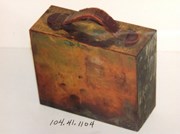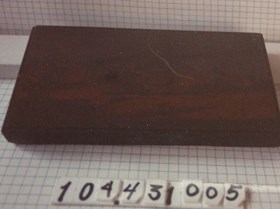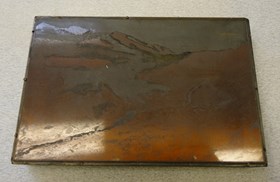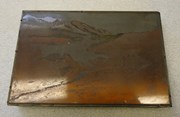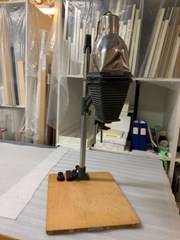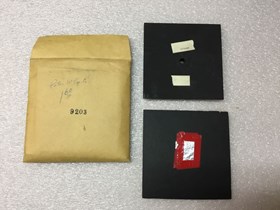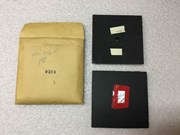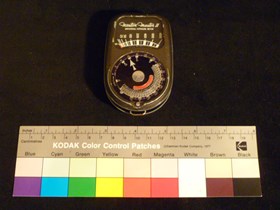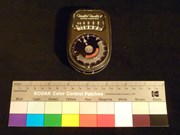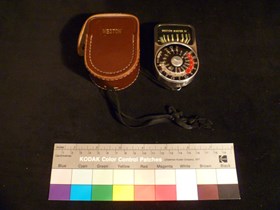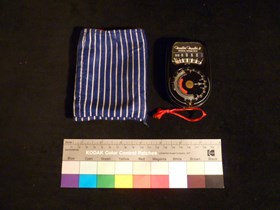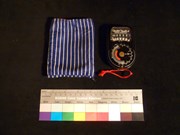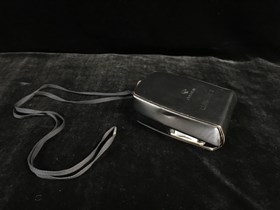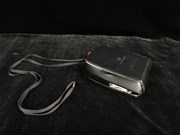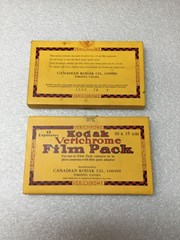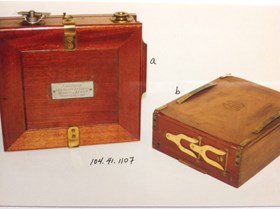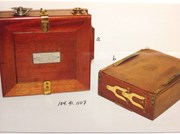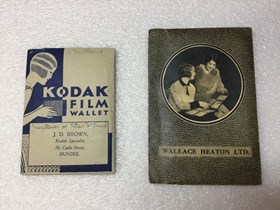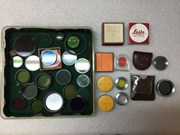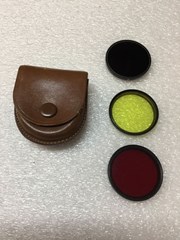Narrow Results By
Cut-Film Holder
https://archives.whyte.org/en/permalink/artifact104.41.1104
- Date
- 1885 – 1900
- Material
- metal; skin
- Catalogue Number
- 104.41.1104
- Description
- Metal box with opening compartments and leather carrying handle marked “45”. “Pat. May 31. 87. Aug. 3. 90” stamped on top. Spring loaded film changing apparatus inside.
1 image
- Title
- Cut-Film Holder
- Date
- 1885 – 1900
- Material
- metal; skin
- Dimensions
- 4.5 x 11.5 cm
- Description
- Metal box with opening compartments and leather carrying handle marked “45”. “Pat. May 31. 87. Aug. 3. 90” stamped on top. Spring loaded film changing apparatus inside.
- Subject
- photography
- Vaux family
- Credit
- Gift of Molly Vaux, New York, USA, 1999
- Catalogue Number
- 104.41.1104
Images
This material is presented as originally created; it may contain outdated cultural descriptions and
potentially offensive content.
Read more.
Developing Tray
https://archives.whyte.org/en/permalink/artifact104.41.0272
- Date
- c. 1900
- Material
- ceramic; enamel
- Catalogue Number
- 104.41.0272
- Description
- A white tray with different coloured speckles all over with a pouring spout at one corner. On the side with the pouring spout is a stamp that reads “GRANITINE” in an outer ring of a circle with a symbol or logo in the middle.
1 image
- Title
- Developing Tray
- Date
- c. 1900
- Material
- ceramic; enamel
- Dimensions
- 4.9 x 15.0 x 21.5 cm
- Description
- A white tray with different coloured speckles all over with a pouring spout at one corner. On the side with the pouring spout is a stamp that reads “GRANITINE” in an outer ring of a circle with a symbol or logo in the middle.
- Credit
- Gift of Pearl Evelyn Moore, Banff, 1977
- Catalogue Number
- 104.41.0272
Images
This material is presented as originally created; it may contain outdated cultural descriptions and
potentially offensive content.
Read more.
- Date
- 1890 – 1910
- Material
- metal
- Catalogue Number
- 110.02.1011
- Description
- Metal tube with lid and paper label reading: “Glaciers. From Will’s office. 2/4. 1909.” Contained 3 drawings on linen (now in Archives Inventory 2014 ).
- Title
- Document Tube
- Date
- 1890 – 1910
- Material
- metal
- Dimensions
- 4.0 x 35.5 cm
- Description
- Metal tube with lid and paper label reading: “Glaciers. From Will’s office. 2/4. 1909.” Contained 3 drawings on linen (now in Archives Inventory 2014 ).
- Credit
- Gift of Molly Vaux, New York, USA, 1999
- Catalogue Number
- 110.02.1011
This material is presented as originally created; it may contain outdated cultural descriptions and
potentially offensive content.
Read more.
Engraving Plate
https://archives.whyte.org/en/permalink/artifact104.43.1005
- Date
- 1930 – 1970
- Material
- wood; metal, copper
- Catalogue Number
- 104.43.1005
- Description
- A rectangle of wood with a metal plate attached. The copper plate has an image on it.This item was transferred to the Archives by SS in May/June 2014.
1 image
- Title
- Engraving Plate
- Date
- 1930 – 1970
- Material
- wood; metal, copper
- Description
- A rectangle of wood with a metal plate attached. The copper plate has an image on it.This item was transferred to the Archives by SS in May/June 2014.
- Subject
- photography
- Credit
- Gift of Arthur Oliver Wheeler, 1975
- Catalogue Number
- 104.43.1005
Images
This material is presented as originally created; it may contain outdated cultural descriptions and
potentially offensive content.
Read more.
Engraving Plate
https://archives.whyte.org/en/permalink/artifact104.43.1011
- Date
- 1890 – 1910
- Material
- wood; metal; paper
- Catalogue Number
- 104.43.1011
- Description
- Two metal engraving plates mounted on wooden blocks. a) has image of mountain scene with glacier. Written on back of block: “Last Cut. 1501. William S. Vaux Jr. 1715 Arch St. Philada.” b) has paper label affixed to back of block: “American [?] Glacier,” handwritten on side of block: “Asulkan Glacie…
1 image
- Title
- Engraving Plate
- Date
- 1890 – 1910
- Material
- wood; metal; paper
- Dimensions
- 2.5 x 12.0 x 18.0 cm
- Description
- Two metal engraving plates mounted on wooden blocks. a) has image of mountain scene with glacier. Written on back of block: “Last Cut. 1501. William S. Vaux Jr. 1715 Arch St. Philada.” b) has paper label affixed to back of block: “American [?] Glacier,” handwritten on side of block: “Asulkan Glacier” and front has image of mountain with glacier and rocks. Stamped on side of block: “Electro Light Engraving Co. New York.”
- Credit
- Gift of Molly Vaux, New York, USA, 1999
- Catalogue Number
- 104.43.1011
Images
This material is presented as originally created; it may contain outdated cultural descriptions and
potentially offensive content.
Read more.
- Date
- 1930 – 1950
- Material
- wood; metal; plastic; glass;
- Catalogue Number
- 104.41.0163
- Description
- Metal Kodak Precision Enlarger mounted on a wooden board with power outlets and power switch mounted beside the base of the enlarger. The support arm mostly consists of a silver metal pole onto which the dull grey metal enlarger support is mounted - a plastic knob on one side allows the enlarger su…
1 image
- Title
- Enlarger
- Date
- 1930 – 1950
- Material
- wood; metal; plastic; glass;
- Dimensions
- 105.0 x 44.5 x 55.7 cm
- Description
- Metal Kodak Precision Enlarger mounted on a wooden board with power outlets and power switch mounted beside the base of the enlarger. The support arm mostly consists of a silver metal pole onto which the dull grey metal enlarger support is mounted - a plastic knob on one side allows the enlarger support to move up and down the support arm. The enlarger itself consists of a shiny metal dome with a fabric-wrapped power cord coming out the top [most likely the house for the light source] mounted on top of the grey metal frame [to which the enlarger support is attached] and into which several different negative trays can be fit, below the frame are dark grey fabric bellows that can be adjusted along a set of metal poles, the bottom of the bellows are attached to a smaller grey metal frame that also houses the focussing lens and a coloured filter that can be rotated in and out of frame.
- Subject
- Nicholas Morant
- photography
- photograph equipment
- camera equipment
- darkroom
- photograph developing;
- Credit
- Gift of Nicholas Morant, Banff, 2006
- Catalogue Number
- 104.41.0163
Images
This material is presented as originally created; it may contain outdated cultural descriptions and
potentially offensive content.
Read more.
- Date
- 1930 – 1960
- Material
- paper; cardboard; wood;
- Catalogue Number
- 104.51.1003
- Description
- Square manilla envelope with one wooden square and one cardboard square with unknown purposes inside. The envelope has “Peter Whyte” written in cursive above “1.60” written in pencil - “9203” is stamped in black in the middle. The wooden square has a hole drilled in the middle and angled edges, mak…
1 image
- Title
- Envelope
- Date
- 1930 – 1960
- Material
- paper; cardboard; wood;
- Dimensions
- 0.5 x 11.9 x 11.9 cm
- Description
- Square manilla envelope with one wooden square and one cardboard square with unknown purposes inside. The envelope has “Peter Whyte” written in cursive above “1.60” written in pencil - “9203” is stamped in black in the middle. The wooden square has a hole drilled in the middle and angled edges, making one side a slightly smaller square than the other, and there are two small pieces of white adhesive tape, one of which has random letters and numbers typed on it [possibly a spacer for a tripod]. The cardboard square has a small hole poked in the middle and blocked off on one side with what appears to be tinfoil taped down with several layers of red adhesive tape.
- Subject
- photography
- Peter Whyte;
- Credit
- Gift of Catharine Robb Whyte, O. C., Banff, 1979
- Catalogue Number
- 104.51.1003
Images
This material is presented as originally created; it may contain outdated cultural descriptions and
potentially offensive content.
Read more.
Exposure Meter
https://archives.whyte.org/en/permalink/artifact104.41.1118
- Date
- 1888
- Material
- metal; paint; plastic
- Catalogue Number
- 104.41.1118
- Description
- Hand held exposure/light meter made by Weston Electrical Instrument Company in a grey metal finish. Along both sides of the meter are a series of protruding lines that allow one to safely grip the object. At the bottom of the artifact there is a metal hook, which would have allowed a string to be a…
1 image
- Title
- Exposure Meter
- Date
- 1888
- Material
- metal; paint; plastic
- Dimensions
- 2.0 x 6.0 x 9.5 cm
- Description
- Hand held exposure/light meter made by Weston Electrical Instrument Company in a grey metal finish. Along both sides of the meter are a series of protruding lines that allow one to safely grip the object. At the bottom of the artifact there is a metal hook, which would have allowed a string to be attached like on the other Weston meter’s owned by Nicholas. There is also no longer a case to protect this particular object. In the top of the exposure meter there is a clear plastic covering. Along the very top there us the name of the manufacturer in white cursive lettering that reads “Weston Master II” and written underneath in capital letters “UNIVERSAL EXPOSURE METER.” Below this is the light scale where the value of the scene would be indicated. The scale contains the values “0” “25” “50” “100” “200” “400” “800” “1600,” which means that the two values on this instrument are calibrated 0-50 and 0-1600. (candles per square foot.)Below there is a circular face with several figures and a dial that turns/rotates. The outside row of figures on the exposure control dial represents the light value settings and corresponds to the light values on the light scale. Below the round dial there is a tiny circular button that is used to set the exposure control dial for film speed. As the dial turns it reveals the “EMULSION SPEED” with a red baize finish that has become worn throughout its life. The row of figures at the bottom of the top dial is the f/stop values and has an “f” to make this more apparent for the user. The row of figures directly below the f/stop settings are the shutter speeds. After setting the exposure control dial to the light value obtained on the light scale, any of the combinations of f/stop and shutter speed directly opposite each other are correct. On the rear of the meter there is a black plastic covering that contains several circular cut outs that are called a hir.ged baffle. This can be swung open (against the case) using the gold latch, which clips into a tiny hole or socket when the user wishes it to be closed. When opened the light sensitive photo cell is directly beneath this baffle and contains several protruding circles. When the baffle is open, the scale range is 0-50; when the baffle is closed, the scale range is 0-1600. Below there is an oval shaped face with extensive information that is held in place with two small screws on both the viewer left and right side. There is silver lettering on a black background that reads “WESTON ELEC. INST. CORP.” “NEWARK, N.J., U.S.A.” A silver backing separates the patent information and has black writing that reads “MODEL 735” on the viewer left side. On the viewer right side the number “7454510” is engraved. In the middle there is a gold-coloured screw with the words “ZERO CORRECTOR” written in black. Below this there is the patent information; “U.S. PATENTS” “2,274,441” “2,073,790” “2,346,555” “2,137,466” “2,463,770.” Below these numbers are the “FOREIGN PATENTS” “FRENCH 862,770” “BRITISH 531,996” “CAN. 347,085” “CAN. 411,975” At the very bottom underneath there is the manufacturer’s location; “MADE IN U.S.A.”
- Subject
- photography
- Nick Morant
- Credit
- Gift of Nicholas Morant, Banff, 2006
- Catalogue Number
- 104.41.1118
Images
This material is presented as originally created; it may contain outdated cultural descriptions and
potentially offensive content.
Read more.
- Date
- 1888
- Material
- leather; metal; nylon; plastic; thread; paint
- Catalogue Number
- 104.41.1119 a-b
- Description
- Hand held light meter in a pear shape with a stainless steel body and leather case. Along both sides of the meter are a series of protruding lines that allow one to safely grip the object. On the viewer right there is a pointer lock, which is locked when positioned upwards and released when positio…
1 image
- Title
- Exposure Meter
- Date
- 1888
- Material
- leather; metal; nylon; plastic; thread; paint
- Dimensions
- 2.0 x 5.0 x 9.0 cm
- Description
- Hand held light meter in a pear shape with a stainless steel body and leather case. Along both sides of the meter are a series of protruding lines that allow one to safely grip the object. On the viewer right there is a pointer lock, which is locked when positioned upwards and released when positioned downward. At the bottom of the artifact there is a metal hook, which has a black string running through. In the top of the light meter there is clear plastic covering. Written in capital letters is “WESTON MATER IV” above the light scale. The lights scale contains the numbers “0” “25” “50” “100” “200” “400” “800” “1600,” which means that the 2 values calibrated on this instrument are 0-50 and 0-1600.Below there is another light scale in the form of a circular face with several figures and a dial that turns/rotates. The dial on the outside has a series of protruding lines to make movement easier and contains a row of figures. This dial controls the lens aperture (f/stop) scale and has a series of values representing the focal length of the lens; “1” “1.4” “2” “2.8” “4” “5.6”. On the same dial there is also the letters “EVS,” which stands for the exposure value setting with a cut out window that reveals the EVS values. Working in a clockwise direction (on the same dial) there is also the letters “U,” “A with “1/2” over top,” an enclosed arrow that is known as the normal arrow, a “C” with “2x” on top of it, and a “0”. As this dial is turned it reveals a partly red baize and black numbers on a silver background that represents the shutter speeds in fractions of seconds. The inside dial has a series of light scale values and an exposure index window that line up with the “U,” “A,” normal arrow, “C,” and “0.” On the opposite side of the exposure index window is the exposure index knob. On the rear of the meter there is a black plastic covering that contains several circular cut outs that are called a hir.ged baffle. This can be swung open (against the case) using the gold latch, which clips into a tiny hole or socket when the user wishes it to be closed. When opened the light sensitive photo cell is directly beneath this baffle and contains several protruding circles. When the baffle is open, the scale range is 0-50; when the baffle is closed, the scale range is 0-1600. Below there is an oval shaped face with extensive information that is held in place with two small screws on both the viewer left and right side. There is black lettering on a silver background that reads “UNIVERSAL EXPOSURE METER” “MODEL 745” SER.W” and “107522” engraved. Below the manufacturer information is listed; “DAYSTROM. INCORPORATED” “WESTON INSTRUMENTS DIVISION”. “NEWARK. N.J.. U.S.A.” In the middle there is a gold-coloured screw with the words “ZERO CORRECTOR” written in black. On the viewer left side of the zero corrector there is patent information; “U.S. PATENTS” “2463770” and on the viewer right side “FOREIGN PATS” “CAN. 411975”. At the very bottom on either side of a circular cut out are “ASA” and “K=1.0” written. Underneath “MADE IN JAPAN” has also been written.There is also a brown leather case with this object. The front has “WESTON” written in gold letters. On the viewer left there is a brown button that allows the case to be opened or fastened shut. The leather has been stitched together with light brown thread that is visible. The bottom of the case has an opening for the black string to be strung through so that the light meter and case are attached. On the rear there is a brown leather strap stitched.
- Subject
- photography
- Nick Morant
- Credit
- Gift of Nicholas Morant, Banff, 2006
- Catalogue Number
- 104.41.1119 a-b
Images
This material is presented as originally created; it may contain outdated cultural descriptions and
potentially offensive content.
Read more.
- Date
- 1888
- Catalogue Number
- 104.41.1120 a-b
- Description
- Hand held light meter in a pear shape with a stainless steel body and leather case. Along both sides of the meter are a series of protruding lines that allow one to safely grip the object. At the bottom of the artifact there is a metal hook, which has a red string running through.There is a clear p…
1 image
- Title
- Exposure Meter
- Date
- 1888
- Description
- Hand held light meter in a pear shape with a stainless steel body and leather case. Along both sides of the meter are a series of protruding lines that allow one to safely grip the object. At the bottom of the artifact there is a metal hook, which has a red string running through.There is a clear plastic covering located at the top of the meter. Written in cursive letters is the company name “WESTON MATER II”. Underneath this written in capital letters is “UNIVERSAL EXPSOURE METER”. The light scale underneath contains the numbers “0” “25” “50” “100” “200” “400” “800” “1600,” which means that the 2 values calibrated on this instrument are 0-50 and 0-1600. Underneath the scale the word “Light” is present. Below there is another light scale in the form of a circular face with several figures and a dial that turns/rotates. The outside row of figures on the exposure control dial represents the light value settings and corresponds to the light values on the light scale at the top. The row of figures at the bottom of the top dial is the f/stop values and has an “f” to make this more apparent for the user.. On the same dial there is silver letters that have a line that correspond to the figures on the outside dial; “U,” “A with “1/2” underneath,” an arrow that is known as the normal arrow, a “C” with “2x” below it, and a “0”. As this dial is turned it reveals a partly red baize and the emulsion speed, which is self-evident as the words “EMULSION SPEED” are present. The row of figures directly below the f/stop settings are the shutter speeds. The outside row of figures is the light values, which is apparent as the word “LIGHT” with an arrow points to these values. After setting the exposure control dial to the light value obtained on the light scale, any of the combinations of f/stop and shutter speed directly opposite each other are correct. Below the round dial there is a tiny circular button that is used to set the exposure control dial for film speed.On the rear of the meter there is a black plastic covering that contains several circular cut outs that are called a hir.ged baffle. This can be swung open (against the case) using the gold latch, which clips into a tiny hole or socket when the user wishes it to be closed. When opened the light sensitive photo cell is directly beneath this baffle and contains several protruding circles. When the baffle is open, the scale range is 0-50; when the baffle is closed, the scale range is 0-1600. Below there is an oval shaped face with extensive information that is held in place with two small screws on both the viewer left and right side. There is silver lettering on a black background that reads “WESTON ELEC. INST. CORP.” “NEWARK, N.J., U.S.A.” A silver backing separates the patent information and has black writing that reads “MODEL 735” on the viewer left side; “No” is present in the middle; “8284703” is engraved on the viewer right side. In the middle there is a brass screw with the words “ZERO CORRECTOR” written in black around its circumference. On the viewer left side of the zero corrector is the patent information; “U.S. PATENTS” “1,779,574” “1,982,406” “2,073,790” and on the viewer right side continued patent information “U.S. PATENTS” “2,137,466” “2,274,441” “2,346,555”. Below these numbers are the “FOREIGN PATENTS” “FRENCH 862,770” “BRITISH 531,996” “CAN. 347,085” “CAN. 411,975” At the very bottom underneath there is the manufacturer’s location; “MADE IN U.S.A.” written in black on a silver background.There is also a blue case with white stripes and a red inner lining that would be used to protect the case. This would not have been originally sold with the exposure meter and was most likely hand made in an effort to protect the meter. Blue stitches hold the fabric together and are visible.
- Subject
- photography
- Nick Morant
- Credit
- Gift of Nicholas Morant, Banff, 2006
- Catalogue Number
- 104.41.1120 a-b
Images
This material is presented as originally created; it may contain outdated cultural descriptions and
potentially offensive content.
Read more.
- Date
- 1933 – 1949
- Material
- plastic; paint; leather; metal; fabric
- Catalogue Number
- 104.41.1123 a-b
- Description
- (a)Gossen Lunasix exposure and colour meter in a pear shape with leather case. The light meter device measures the amount of light that is appropriate to achieve the proper exposure, indicating for the users which shutter speed and f-number should be selected. Along the top of the exposure meter in…
1 image
- Title
- Exposure Meter
- Date
- 1933 – 1949
- Material
- plastic; paint; leather; metal; fabric
- Dimensions
- (a)2.5; (b)04.5 x (a)6.5; (b)7.5 x (a)11.5; (b)12.0 cm
- Description
- (a)Gossen Lunasix exposure and colour meter in a pear shape with leather case. The light meter device measures the amount of light that is appropriate to achieve the proper exposure, indicating for the users which shutter speed and f-number should be selected. Along the top of the exposure meter in the viewer left corner is a white bulb-like part next to an open circular window that measures the amount of light present in the scene. When the converter slide, located along the viewer right side, is moved to the right and clicked into position the round window is open and ready to read the scene. At the top, on the face of the meter, the light measurement (scale) is present. This shows how much light is present in the scene and directly relates to the remaining scales on the meter. Below the light scale is a plexiglass film-speed setting disc with grooves that allow the operator to easily move the dial. In the middle of the dial there is the Lunasix manufacturer symbol. On viewer left side of this emblem is the DIN exposure index of the film in use; on the proper right side of this emblem is the ASA exposure index of the film in use. By moving the dial one adjusts the film-speed setting, which is indicated in the DIN and ASA boxes, whereby the index number is lined up against the triangular white marker in the respective window. A manual would have originally been sold with the object giving a more comprehensive overview of the film-speed table with a technical appendix. On the rear of the object in the viewer right corner one will see the correct position of the 2 batteries indicated through a tiny diagram. Below this is a metal battery chamber. Below this are the words “2 Batt. Mallory” “PX 625 o. PX 13”. To the viewer left of this writing is the ridged slide used for battery testing. Above the ridged slide are the words “Batt. Contr.” with a solid arrow below. Below the battery information is the table of footcandle (LUX) equivalents. In the middle of the table is the zero adjustable screw with an arrow pointing in both directions. AT the very bottom painted on the surface is the location of manufacturing; “GERMANY (WEST)” above a cutout window revealing the patent number; “4D01673”. (b) There is also a black leather case with the object. The inside of the case has gray suede lining, which would have helped avoid scratching and marking of the meter. The case has been carefully designed to retrofit the meter, which is apparent through the tiny leather strap present when the case is opened. These designs allow the object to be formly held into place further safeguarding it. At the bottom of the case there is a black button that allows the case to be opened and fastened shut. When the case is fastened shut, the name of the manufacturer “Gossen” appears imprinted and is upside down. Below this, also upside down, “LUNASIX 3” has been applied in silver ink. Along the viewer right side the case has a cutout that perfectly fit the converter slide. On the rear “MADE IN GERMANY” appears in a receded box with protruding lettering. The bottom of the case, where the button is located, contains an opening for the black string to be strung through. The string, which has been tied to the exposure meter, measures 49.0 cm and has a metal piece holding the ends of the string in place. This would have given the user greater security when working with the exposure meter.
- Subject
- photography
- Nick Morant
- Credit
- Gift of Nicholas Morant, Banff, 2006
- Catalogue Number
- 104.41.1123 a-b
Images
This material is presented as originally created; it may contain outdated cultural descriptions and
potentially offensive content.
Read more.
- Date
- 1890 – 1900
- Material
- cardboard;
- Catalogue Number
- 110.01.0293 a-c
- Description
- Three empty boxes for one Transparent Film Cartridge meant to be used in the Kodak No. 2 Bullet Camera - each cartridge could take twelve 3 1/2 inch exposures. Each box has a black and white paper label adhered across the top of the lid with the product and manufacturer details printed throughout -…
1 image
- Title
- Film Box
- Date
- 1890 – 1900
- Material
- cardboard;
- Dimensions
- 3.8 x 4.0 x 10.3 cm
- Description
- Three empty boxes for one Transparent Film Cartridge meant to be used in the Kodak No. 2 Bullet Camera - each cartridge could take twelve 3 1/2 inch exposures. Each box has a black and white paper label adhered across the top of the lid with the product and manufacturer details printed throughout - on the bottom is a white and red paper label with a warning to develop the film before May 1st, 1900. All three boxes have various kinds of writing throughout the exteriors - two have notes written on one long side in pencil by Russell Robb [most likely Catharine’s father].
- Subject
- photography
- photographic developing
- film
- Credit
- Gift of Catharine Robb Whyte, O. C., Banff, 1979
- Catalogue Number
- 110.01.0293 a-c
Images
This material is presented as originally created; it may contain outdated cultural descriptions and
potentially offensive content.
Read more.
- Date
- 1930 – 1960
- Material
- cardboard; metal;
- Catalogue Number
- 110.01.0294 a-c
- Description
- Three empty boxes for 16 mm Cine-Kodak Kodachrome and Panchromatic Safety Films. Two boxes have the empty metal film reels inside. The exteriors of the boxes are covered in product and manufacturer details and, on the back, are shipping details for when the film has been developed - two are address…
1 image
- Title
- Film Box
- Date
- 1930 – 1960
- Material
- cardboard; metal;
- Dimensions
- 2.7 x 9.8 x 9.8 cm
- Description
- Three empty boxes for 16 mm Cine-Kodak Kodachrome and Panchromatic Safety Films. Two boxes have the empty metal film reels inside. The exteriors of the boxes are covered in product and manufacturer details and, on the back, are shipping details for when the film has been developed - two are addressed from Peter Whyte in Banff and one is addressed from “MRS PETER WHYTE” in Concord.
- Credit
- Gift of Catharine Robb Whyte, O. C., Banff, 1979
- Catalogue Number
- 110.01.0294 a-c
Images
This material is presented as originally created; it may contain outdated cultural descriptions and
potentially offensive content.
Read more.
- Date
- 1930 – 1980
- Material
- leather; metal; wood; paper
- Catalogue Number
- 104.41.0093 a-h
- Description
- Hard-sided black carry case with a hinged lid and unlined wooden interior. All corners are capped with metal, mostly rusted - three metal latches are also extensively rusted (the centre one is a lock latch). Running along the length of the lid and the bottom of the case are two parallel wooden runn…
1 image
- Title
- Film Case
- Date
- 1930 – 1980
- Material
- leather; metal; wood; paper
- Dimensions
- 22.3 x 21.2 x 62.4 cm
- Description
- Hard-sided black carry case with a hinged lid and unlined wooden interior. All corners are capped with metal, mostly rusted - three metal latches are also extensively rusted (the centre one is a lock latch). Running along the length of the lid and the bottom of the case are two parallel wooden runners. Also on the lid is a hard leather handle attached to the lid with metal loops - attached to both handle loops are several remnants of paper tags and a leather travel tag with a clear plastic window. Visible through the window is a stained paper tag that reads “N Morant Special Photographer Public Relations and Advertising Canadian Pacific Banff, Alberta.” Inside the lid is a “NATIONAL FILM BOARD OF CANADA Exposed Negative” card depicting a woman in a pale green bikini. Drawn on the inside of the lid in black, yellow, and red is a caricature of a face with a thought bubble that reads “AUNT MARTHA LIKES THIS ONE.” The exterior of the case is covered in faded and torn travel stickers and labels, there is also “D7” spray painted in yellow on the lid under the handle, on both short sides, and on the back. Inside the case are three black “KODAK HARD RUBBER TANK 4x5” containers. In one tank are two cardboard boxes - one is green and contains an Eastman timer and the other is a yellow “EASTMAN THERMOMETER” box with the thermometer inside. The second tank contains two circular metal supports for developing rolls of film negatives, a white metal Kodak film canister (empty), and a blue cardboard box with another metal film processor inside. The third tank contains a cylindrical container that has something inside of it, but it does not open.
- Credit
- Gift of Nicholas Morant, Banff, 2006
- Catalogue Number
- 104.41.0093 a-h
Images
This material is presented as originally created; it may contain outdated cultural descriptions and
potentially offensive content.
Read more.
- Date
- 1930 – 1959
- Material
- leather; metal; fabric; wood
- Catalogue Number
- 104.41.0082 a-c
- Description
- Metal developing tanks dimensions: 13.6x11.6x17.2 or smaller.Torn and crinkled label free-floating inside case reads “DALLON SS TANKS 3 1/4 X 4 1/4 24 CAPACITY.” DALLON most likely refers to David Allan (Dallan) sheet metal workers, specializing in darkroom products, of London England. Case is a ha…
1 image
- Title
- Film Developer
- Date
- 1930 – 1959
- Material
- leather; metal; fabric; wood
- Dimensions
- 16.0 x 17.5 x 30.0 cm
- Description
- Metal developing tanks dimensions: 13.6x11.6x17.2 or smaller.Torn and crinkled label free-floating inside case reads “DALLON SS TANKS 3 1/4 X 4 1/4 24 CAPACITY.” DALLON most likely refers to David Allan (Dallan) sheet metal workers, specializing in darkroom products, of London England. Case is a hard-sided black leather box with a lid that hinges open and held open with a brown leather strip on the left-hand side - also has silver metal clasps and carry handle on the front of the case. The case’s interior is lined with grey fabric and the main compartment is divided into two equal sections that house the metal developing tanks. Nailed to the bottoms of each compartment are pieces of wood to prevent the tanks from sliding around. The metal tanks have lids that lift off - one has notches that could have been used to latch the lid down, but no latches remain, and the other has holes in the middle of the lid from where a handle used to be, the handle is missing. Inside the tanks are cradles with lifting handles at either end and removable curved brackets to mount the film in. One tank has what appears to be a vent with a cap on one end, the cap appears to be stuck in place. Folded-up newspaper packed into empty spaces of case beside the tanks, removed.
- Credit
- Gift of Nicholas Morant, Banff, 2006
- Catalogue Number
- 104.41.0082 a-c
Images
This material is presented as originally created; it may contain outdated cultural descriptions and
potentially offensive content.
Read more.
- Date
- 1938 – 1945
- Material
- cardboard;
- Catalogue Number
- 104.41.0204 a,b
- Description
- Two boxes of 12 10x15cm Kodak Verichrome Film Packs with broken seals. Each box is mostly yellow with black and red manufacturer and product details throughout - there are two paper adhesive stickers holding the box closed, the one that has the expiration date on it on each box is broken.Verichrome…
1 image
- Title
- Film Pack
- Date
- 1938 – 1945
- Material
- cardboard;
- Dimensions
- 1.4 x 17.9 x 10.9 cm
- Description
- Two boxes of 12 10x15cm Kodak Verichrome Film Packs with broken seals. Each box is mostly yellow with black and red manufacturer and product details throughout - there are two paper adhesive stickers holding the box closed, the one that has the expiration date on it on each box is broken.Verichrome was a kind of panchromatic film that yielded high-quality black and white photographs thanks to the fine-grained emulsion. Film Packs were basic forms of storage meant to be used shortly after purchasing as their [mostly] paper packaging did not keep out oxygen well and had a tendency to fog over time, rendering the film unusable in the long term. It was replaced by the more stable Verichrome Pan in the 1950s.
- Credit
- Gift of Robert Crosby Family, Banff, 1998
- Catalogue Number
- 104.41.0204 a,b
Images
This material is presented as originally created; it may contain outdated cultural descriptions and
potentially offensive content.
Read more.
- Date
- 1885 – 1900
- Material
- wood; metal
- Catalogue Number
- 104.41.1107 a,b
- Description
- (a) Wooden film roller with brass fittings. Metal plate on top reads: “EASTMAN DRY PLATE & FILM CO. Rochester, N.Y., U.S.A. PATENTED MAY 5, 1885.” (b) Wooden film roller with brass fittings, top stamped: “EASTMAN KODAK CO. PAT. MAY 5, 1885. OTHER PATENTS APPL’D FOR IN ALL COUNTRIES.”
1 image
- Title
- Film Roller
- Date
- 1885 – 1900
- Material
- wood; metal
- Dimensions
- 6.0 x 18.0 cm
- Description
- (a) Wooden film roller with brass fittings. Metal plate on top reads: “EASTMAN DRY PLATE & FILM CO. Rochester, N.Y., U.S.A. PATENTED MAY 5, 1885.” (b) Wooden film roller with brass fittings, top stamped: “EASTMAN KODAK CO. PAT. MAY 5, 1885. OTHER PATENTS APPL’D FOR IN ALL COUNTRIES.”
- Subject
- photography
- Vaux family
- Credit
- Gift of Molly Vaux, New York, USA, 1999
- Catalogue Number
- 104.41.1107 a,b
Images
This material is presented as originally created; it may contain outdated cultural descriptions and
potentially offensive content.
Read more.
- Date
- 1930 – 1931
- Material
- paper;
- Catalogue Number
- 104.41.0219 a,b
- Description
- Two paper folding envelopes for holding film and/or developed prints - one is Kodak and one is from Wallace Heaton Ltd., a developing studio in London England. Both wallets fold open to show two open-sided pouches where either films or prints could be slotted and have advertising for other services…
1 image
- Title
- Film Wallet
- Date
- 1930 – 1931
- Material
- paper;
- Dimensions
- 0.3 x 11.3 x 16.7 cm
- Description
- Two paper folding envelopes for holding film and/or developed prints - one is Kodak and one is from Wallace Heaton Ltd., a developing studio in London England. Both wallets fold open to show two open-sided pouches where either films or prints could be slotted and have advertising for other services/products printed on them. The Kodak wallet is predominantly white and blue, has a small slip of paper that appears to have “13/5/30 [?] Winton” and several numbers written on it in pencil, several numbers written in pencil on the left-hand side inside, and “Scotland / Negatives of Pete’s Scotland” written in black ink by Catharine Whyte on the front cover. The Wallace Heaton wallet is predominantly grey and black with a picture of two women looking at a photo album on the front cover, a slip of paper that appears to be a receipt for the Browns Hotel made out to “Nice Esq” tucking inside, “Scotland / Nice Esq / egative Scotland 1930” written in different hands on the back [everything except “Nice Esq” written by Catharine Whyte].
- Credit
- Gift of Catharine Robb Whyte, O. C., Banff, 1979
- Catalogue Number
- 104.41.0219 a,b
Images
This material is presented as originally created; it may contain outdated cultural descriptions and
potentially offensive content.
Read more.
- Date
- 1930 – 1970
- Material
- plastic; fabric; felt; leather; glass; cardboard;
- Catalogue Number
- 104.41.0212
- Description
- Square clear plastic box lined with green felt containing 26 camera filters and 2 lens caps - 6 filters are in various containers, one is unopened. Most filters were manufactured by Leitz Wetzler [the company changed its name to Leica in 1986], some are Kodak, and two are Zeiss. Filters include yel…
1 image
- Title
- Filter Box
- Date
- 1930 – 1970
- Material
- plastic; fabric; felt; leather; glass; cardboard;
- Dimensions
- 3.8 x 23.2 x 23.2 cm
- Description
- Square clear plastic box lined with green felt containing 26 camera filters and 2 lens caps - 6 filters are in various containers, one is unopened. Most filters were manufactured by Leitz Wetzler [the company changed its name to Leica in 1986], some are Kodak, and two are Zeiss. Filters include yellow, orange, red, blue, tinted, and clear patterned glass.
- Credit
- Gift of Catharine Robb Whyte, O. C., Banff, 1979
- Catalogue Number
- 104.41.0212
Images
This material is presented as originally created; it may contain outdated cultural descriptions and
potentially offensive content.
Read more.
- Date
- 1930 – 1970
- Material
- metal; glass; leather;
- Catalogue Number
- 104.41.0216
- Description
- Three colour tinted Leica lens filters in a snap-closed leather pouch - one filter is red, one yellow, one very dark red [looks black without a light behind it].
1 image
- Title
- Filter Lens
- Date
- 1930 – 1970
- Material
- metal; glass; leather;
- Dimensions
- 2.4 x 5.8 x 6.6 cm
- Description
- Three colour tinted Leica lens filters in a snap-closed leather pouch - one filter is red, one yellow, one very dark red [looks black without a light behind it].
- Credit
- Gift of Catharine Robb Whyte, O. C., Banff, 1979
- Catalogue Number
- 104.41.0216
Images
This material is presented as originally created; it may contain outdated cultural descriptions and
potentially offensive content.
Read more.


